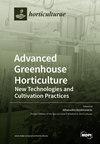Improving the Salt Tolerance of “Old Limachino Tomato” by Using a New Salt-Tolerant Rootstock
IF 3.1
3区 农林科学
Q1 HORTICULTURE
引用次数: 0
Abstract
Salinity is a major constraint limiting the yield of tomatoes. However, grafting strategies may help to overcome the salt toxicity of this important horticultural species if appropriate rootstocks are identified. The present study aimed to test a new rootstock, JUPAFORT1, obtained by crossing the glycophyte Solanum lycopersicum (cv. Poncho Negro) with the halophyte wild-related species Solanum chilense to improve the salinity tolerance of the Chilean tomato landrace Old Limachino Tomato (OLT). Intact OLT plants were exposed to 0, 80, or 160 mM of NaCl for 21 days at the vegetative stage and compared with self-grafted (L/L) and Limachino plants grafted on JUPAFORT1 rootstock (L/R) under a completely randomized design. JUPAFORT1 increased OLT scion vigor in the absence of salt but did not significantly increase fresh weight under stress conditions. However, JUPAFORT1 confers to the scion an anisohydric behavior contrasting with the isohydric behavior of L and L/L plants as indicated by measurements of stomatal conductance; L/R plants were able to maintain their metabolic status despite a slight decrease in the leaf’s relative water content. JUPAFORT1 rootstock also enabled the maintenance of photosynthetic pigment concentrations in the scion in contrast to L and L/L plants, which exhibited a decrease in photosynthetic pigments under stress conditions. L/R plants encountered oxidative stress at the highest stress intensity (160 mM of NaCl) only, while L and L/L plants suffered from oxidative damage at a lower dose (80 mM of NaCl). L/R plants behaved as includer plants and did not sequester Na+ in the root system, in contrast to L and L/L, which behaved as excluder plants retaining Na+ in the root system to avoid its translocation to the shoots. The expression of genes coding for ion transporters (HKT1.1, HKT1.2, LKT1, SKOR, SOS2, and SOS3) in the root system was not modified by salinity in L/R. In contrast, their expression varied in response to salinity in L and L/L. Overall, L/R plants exhibited higher physiological stability than L/L or L plants in response to an increasing NaCl dose and did not require additional energy investment to trigger an adaptative response to salinity. This suggests that the constitutive salinity tolerance of the halophyte S. chilense was maintained in the interspecific rootstock. JUPAFORT1 issued from S. lycopersicum x S. chilense may thus improve salt-stress resilience in OLT tomatoes. Additional studies are required to identify the molecular components involved in the root-to-shoot signaling pathway in this promising material.使用新型耐盐砧木提高 "老利马奇诺番茄 "的耐盐性
盐碱是限制番茄产量的一个主要因素。然而,如果能找到合适的砧木,嫁接策略可能有助于克服这一重要园艺品种的盐毒问题。本研究旨在测试一种新砧木--JUPAFORT1,它是由糖叶植物番茄(Solanum lycopersicum,cv. Poncho Negro)与盐生野生相关物种番茄(Solanum chilense)杂交获得的,目的是提高智利番茄陆地品种老利马奇诺番茄(Old Limachino Tomato,OLT)的耐盐性。在完全随机设计下,将完整的 OLT 植株暴露在 0、80 或 160 mM NaCl 中 21 天,并与自交植株(L/L)和嫁接在 JUPAFORT1 根茎上的 Limachino 植株(L/R)进行比较。在无盐条件下,JUPAFORT1 提高了 OLT 接穗的活力,但在胁迫条件下并没有显著增加鲜重。然而,根据气孔导度的测量结果,JUPAFORT1 使接穗具有等水行为,这与 L 和 L/L 植物的等水行为截然不同;尽管叶片的相对含水量略有下降,L/R 植物仍能保持其代谢状态。JUPAFORT1 砧木还能维持接穗中光合色素的浓度,而 L 和 L/L 植物则不同,它们在胁迫条件下表现出光合色素的减少。L/R 植株仅在最高胁迫强度(160 毫摩尔 NaCl)下受到氧化胁迫,而 L 和 L/L 植株在较低剂量(80 毫摩尔 NaCl)下就受到氧化损伤。L/R 植株表现为包含型植株,没有将 Na+ 封存在根系中,而 L 和 L/L 则表现为排除型植株,将 Na+ 保留在根系中,以避免其转移到芽中。L/R 根系中编码离子转运体的基因(HKT1.1、HKT1.2、LKT1、SKOR、SOS2 和 SOS3)的表达不受盐度的影响。相反,在 L 和 L/L 中,它们的表达随盐度的变化而变化。总的来说,与 L/L 或 L 植物相比,L/R 植物在 NaCl 剂量增加时表现出更高的生理稳定性,并且不需要额外的能量投入来触发对盐度的适应性反应。这表明盐生植物 S. chilense 的组成型耐盐性在种间砧木中得以保持。因此,从 S. lycopersicum x S. chilense 发出的 JUPAFORT1 可能会提高 OLT 番茄对盐胁迫的适应能力。还需要进行更多的研究,以确定这种有潜力的材料中参与根到芽信号传导途径的分子成分。
本文章由计算机程序翻译,如有差异,请以英文原文为准。
求助全文
约1分钟内获得全文
求助全文

 求助内容:
求助内容: 应助结果提醒方式:
应助结果提醒方式:


